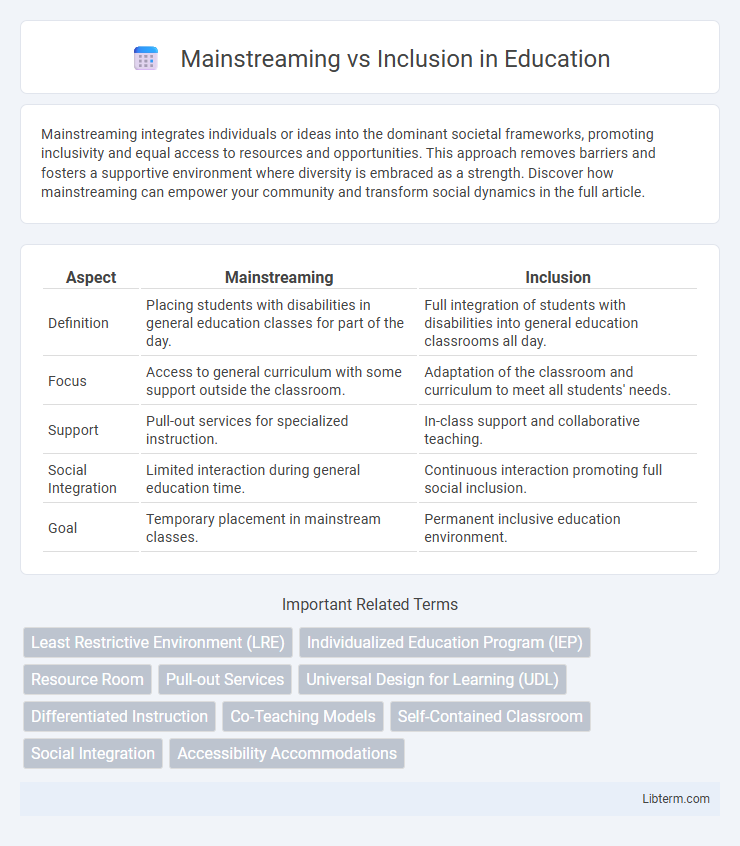Mainstreaming integrates individuals or ideas into the dominant societal frameworks, promoting inclusivity and equal access to resources and opportunities. This approach removes barriers and fosters a supportive environment where diversity is embraced as a strength. Discover how mainstreaming can empower your community and transform social dynamics in the full article.
Table of Comparison
| Aspect | Mainstreaming | Inclusion |
|---|---|---|
| Definition | Placing students with disabilities in general education classes for part of the day. | Full integration of students with disabilities into general education classrooms all day. |
| Focus | Access to general curriculum with some support outside the classroom. | Adaptation of the classroom and curriculum to meet all students' needs. |
| Support | Pull-out services for specialized instruction. | In-class support and collaborative teaching. |
| Social Integration | Limited interaction during general education time. | Continuous interaction promoting full social inclusion. |
| Goal | Temporary placement in mainstream classes. | Permanent inclusive education environment. |
Understanding Mainstreaming and Inclusion
Mainstreaming involves integrating students with special needs into general education classrooms for part or all of the school day, aiming to provide access to the standard curriculum alongside their peers. Inclusion goes further by promoting full participation of all students in regular classrooms, emphasizing tailored support, adaptive teaching strategies, and collaborative environments to meet diverse learning requirements. Understanding the distinction helps educators design effective interventions that foster social integration and academic success for students with disabilities.
Key Differences Between Mainstreaming and Inclusion
Mainstreaming places students with special needs in general education classrooms for part of the day, aiming to integrate them while often providing separate support services outside the classroom. Inclusion involves fully integrating students with disabilities into general education settings throughout the school day, emphasizing collaborative teaching and accessible curriculum tailored to diverse learning needs. Key differences lie in the degree of integration and instructional modifications, with inclusion promoting a holistic, student-centered approach and mainstreaming often maintaining more segregated support structures.
Historical Evolution of Educational Practices
Mainstreaming emerged in the mid-20th century as an educational practice aimed at placing students with disabilities in general classrooms for part of the day while providing specialized support. Inclusion evolved later, particularly from the 1980s onward, promoting full-time education of students with disabilities alongside their non-disabled peers in regular classrooms with necessary accommodations. Both approaches reflect shifting societal attitudes towards disability, moving from segregation towards equality and participation in education.
Core Principles of Mainstreaming
Mainstreaming is grounded in the principle of providing equal access to education by integrating students with diverse abilities into regular classrooms, ensuring they receive appropriate support tailored to their individual needs. It emphasizes the importance of adapting curricula, teaching methods, and learning environments to foster participation and minimize segregation. Core principles include promoting equity, recognizing individual differences, and enhancing social interaction among all students to create an inclusive learning atmosphere.
Core Principles of Inclusion
Mainstreaming emphasizes placing students with disabilities in general education classrooms without significant modifications, while inclusion centers on adapting the learning environment to meet diverse needs, ensuring equitable participation. Core principles of inclusion prioritize accessibility, individualized support, and collaboration among educators, families, and peers to foster a sense of belonging and academic success. Effective inclusion requires ongoing assessment, differentiated instruction, and a commitment to dismantling barriers to learning for all students.
Benefits and Challenges of Mainstreaming
Mainstreaming in education integrates students with special needs into general classrooms, fostering social interaction and access to the standard curriculum, which enhances academic and social development. This approach benefits students by promoting diversity and reducing stigmatization but faces challenges such as inadequate teacher training and resource limitations that can hinder effective support for all learners. Successful mainstreaming requires tailored interventions and collaboration between special education and general educators to address varied student needs and maintain classroom harmony.
Advantages and Limitations of Inclusion
Inclusion promotes diversity by integrating students with special needs into general education classrooms, enhancing social skills and peer relationships. It fosters individualized support and equal opportunities for all students, improving academic and emotional outcomes. However, inclusion may face challenges such as insufficient resources, teacher training gaps, and potential distractions that affect the learning environment.
Impact on Students With Disabilities
Mainstreaming places students with disabilities in general education classrooms for part of the day, which can improve their social skills but may limit access to specialized instruction tailored to their needs. Inclusion fully integrates these students into general education settings with appropriate supports, promoting equal participation and fostering academic and social development more effectively. Research shows that inclusive education enhances self-esteem and academic outcomes for students with disabilities compared to mainstreaming, which sometimes isolates them from peers.
Teacher Roles in Mainstreaming vs Inclusion
Teacher roles in mainstreaming primarily involve adapting existing curriculum and classroom environments to accommodate students with diverse learning needs while maintaining a predominantly typical student group. In inclusion settings, teachers collaborate more intensively with special educators and support staff to create fully accessible and differentiated instruction tailored to every student's unique abilities and challenges. Effective inclusion requires teachers to foster a supportive classroom culture that promotes peer interaction, equity, and individualized learning strategies for all students.
Best Practices for Effective Implementation
Mainstreaming involves placing students with disabilities in general education classrooms for part or all of the day, while inclusion fully integrates these students into regular classes with appropriate supports. Best practices for effective implementation include individualized education plans (IEPs), collaboration among special educators and general teachers, and ongoing professional development. Providing assistive technology and fostering a supportive classroom environment are crucial to ensuring all students' academic and social success.
Mainstreaming Infographic

 libterm.com
libterm.com